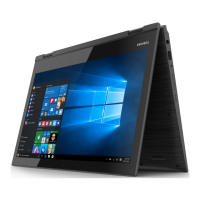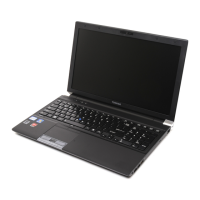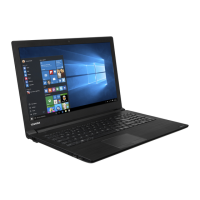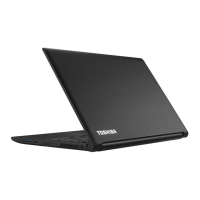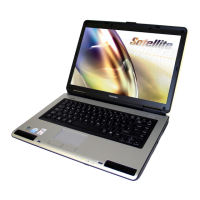
Do you have a question about the Toshiba Satellite Radius L15W-B and is the answer not in the manual?
| Brand | Toshiba |
|---|---|
| Model | Satellite Radius L15W-B |
| Category | Laptop |
| Operating System | Windows 8.1 |
| Processor Speed | 2.16 GHz |
| RAM | 4 GB |
| Storage | 500 GB HDD |
| Display Size | 11.6 inches |
| Display Resolution | 1366 x 768 |
| Touchscreen | Yes |
| Graphics | Intel HD Graphics |
| Battery Life | Up to 6 hours |
| Weight | 2.9 lbs |
| Color | Satin Gold |
Covers copyright, disclaimer, and trademark information for the manual.
Details regulatory compliance information, including FCC and EU declarations.
Explains licensing for video standards used in the product.
Information about ENERGY STAR compliance and energy-saving features.
Guidelines for environmentally responsible disposal of the computer and batteries.
Outlines general safety precautions for using the computer.
Explains the meaning and usage of safety icons found in the manual.
Lists essential hardware and documentation included with the computer.
Explains the formatting and conventions used throughout the user manual.
Identifies components and features of the CL10-B/L10-B model.
Identifies components and features of the CL10W-B/L10W-B model.
Details the location of magnets and potential interference with medical devices.
Describes the internal hardware components of the computer.
Explains the meaning of various power and battery indicator lights.
Provides instructions for operating the computer in tablet mode.
Explains how to change screen orientation in different modes.
Details how to use the touch screen interface and gestures.
Explains how to use the touch pad and its gestures.
Describes the keyboard layout, keys, and special functions.
Explains the CAPS LOCK indicator light and its meaning.
Details the functionality of the F1-F12 keys and their modes.
Explains the function of special Windows keys like Start and context menu keys.
Covers battery types, usage, charging, and handling.
Information on connecting to a Local Area Network (LAN).
Details the computer's memory media slot and supported cards.
Information on connecting external displays to enhance video capabilities.
Describes audio control functions and video mode settings.
Describes pre-installed utilities and how to start them.
Utility for adjusting desktop text size and screen splitting.
Utility to set passwords for restricting computer access.
Customizes hardware settings and peripherals.
BIOS setup utility for viewing and changing BIOS settings.
Manages power consumption and battery life through eco modes.
Configures special functions accessed via keys.
Searches for software updates and alerts from TOSHIBA.
Monitors system functions like power, battery, and cooling.
Highlights unique or advanced features for convenience.
Temporarily turns off power without exiting software.
Saves memory contents to storage before shutting down.
Sets and manages user passwords for the computer.
Sets and manages supervisor passwords for restricted functions.
Procedure to enter a password when starting the computer.
Options for system recovery and creating recovery media.
Step-by-step guide to creating recovery media.
How to restore the system from created recovery media.
How to restore the system from the recovery partition.
Guidelines for effectively identifying and resolving problems.
Initial steps to check before troubleshooting.
Questions to help analyze the cause of a problem.
Troubleshooting steps related to software issues.
Troubleshooting steps related to hardware issues.
General guidance when the computer is not functioning correctly.
Steps to take when keyboard input is not recognized.
How to close unresponsive programs.
Checks to perform if the computer fails to power on.
How to access advanced startup options.
A checklist for hardware and system-related problems.
Troubleshooting power-related issues.
Addresses issues where the computer shuts down due to overheating.
Troubleshooting issues related to AC power connection.
Troubleshooting issues related to the battery.
Resolving issues with the BIOS settings and system date/time.
Troubleshooting problems related to the keyboard.
Troubleshooting issues with the computer's display panel.
Troubleshooting problems related to internal storage.
Troubleshooting issues with memory media cards.
Troubleshooting issues with pointing devices.
Specific troubleshooting steps for the touch pad.
Troubleshooting issues related to USB mice.
Troubleshooting general USB device issues.
Troubleshooting issues related to the sound system.
Troubleshooting issues with external monitors.
Troubleshooting connectivity issues with LAN.
Steps to resolve issues with Wake-on-LAN functionality.
Troubleshooting issues related to Wireless LAN connectivity.
Troubleshooting issues related to Bluetooth connectivity.
Information on how to contact TOSHIBA for additional assistance.
Summarizes the technical specifications of the computer.
Details the physical size and dimensions of the computer.
Specifies operating conditions for ambient temperature, humidity, and altitude.
Lists the power requirements for the AC adapter and computer.
Details the pin assignments for the external RGB monitor port.
Information on AC power cord compatibility and certifications.
Details wireless technology interoperability and compliance.
Details radio frequency and safety standards compliance.
Lists countries/regions where equipment is approved for radio standards.
Provides explanations for various legal footnotes used in the manual.
Discusses CPU performance and factors affecting it.
Explains how main system memory is utilized and displayed.
Factors affecting battery life and its natural degradation.
Discusses the LCD screen and its brightness characteristics.
Explains GPU performance and factors influencing it.
Discusses wireless LAN transmission speed and range factors.
